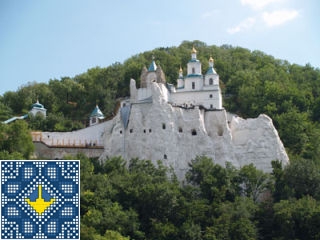|
Sviatohirsk Sights | Sviatohirsk Lavra Cave Monastery Individual and group tours to Sviatohirsk |
The main source of income of Sviatohirsk Cave Monastery was a ferry across Seversky Donets River. In the XVI century the ferry according to the note of German ambassador Sigismund Gerberstein was called "Great Ferry " and was the only one ferry on the river. Therefore it was used not only hunters, trappers, salt-works and even the ambassadors of foreign countries and the road to it was known as "Ambassador Way". In the 60s of XVII century the ferry was transferred to the newly built Mayatsky town but instead the government pays the monastery of annual compensation. The cave structures belonging to the first period of Sviatohirsk Cave Monastery life which have survived to our time are cave chapel, John the Baptist Cave Church, Church of St. Nicholas on the chalk rock, underground Church of Saint Anthony and Theodosius, cells inside the chalk cliffs. The evidence that the Church of St. Nicholas in ancient times was a cave church is still preserved its chancel carved into the chalk rock. With St. Nicholas Church is associated the most popular legend of Sviatohirsk Cave Monastery of the secret construction of the church. When St. Nicholas Church was built the chalk wall was blown up in the morning and announced to the people of the miraculous appearance. Also it was possible to hear legends about the murder of St. Nicholas Church builders by monks to keep the secret of its construction. The story of the murder of builders most likely fiction but the construction of churches in the old days really carried away many lives. All the fault was imperfect technology of coating of gold domes. Now if it is made by gold foil stickers on a specially prepared surface the earlier copper plate coated with an amalgam - a special alloy of gold and mercury. The alloy is all the good that at room temperature it has a density of sour cream and thus can be easily applied with a brush. Then the plate was fired in the kiln, the mercury evaporates and the gold soldered to the substrate. But amalgam has one drawback: it is composed of mercury - poisonous metal. At the end of the XVII century monks laid the first above-ground structures: in 1679 the church was built in honor of the Apostles Peter and Paul and in 1708 - a new stone Cathedral of Dormition. About the original history of the underground Church of Saint Anthony and Theodosius almost nothing is known except that in the XVIII century it was lost. The acquisition of the church was only in 1845 when his position was stated by one centenarian who in his youth had heard the legend about the underground church. An active part in clearing and expansion of the church itself took St. John the Hermit. John the Hermit After his wife's death in 1839 John the Hermit (Ivan Kryukov) entered Glinskaya Pustin under the leadership of abbot Filaret. After 7 years he was ordained into the mantle with the name Ioannicius. With the resumption of Sviatohirsk Cave Monastery in 1844 Ioannicius went to live in the restored monastery. Working in the caves on their clearing Ioannicius liked one of cells and in which in 1850 choosed to live in. Two years later he was tonsured a monastic name John. The cell was very small and not above the arches of the human growth, the light was coming through the narrow hole in the chalk rock. Atmosphere of cell was drastically cold and wet but only after 5 years in his cell was constructed furnace. Dampness was such that clothing could not long served. John the Hermit has lived in cave cell for 17 years. During this time he has gained an understanding of cause and effect, the basic structure of all things, cleansed his soul and mind from worldly life. A week before his death by the will of the abbot a very sick old man was transported to the hospital of Akhtyrskaya Mother of God where the August 24, 1867 passed away peacefully. The Soviet Union Period The events of 1917 and the arrival of the new Soviet rule was a tragedy for Sviatohirsk Cave Monastery - its looting began in January 1918. In the spring of 1919 in the monastery was located a colony of children from Saint Petersburg where education was conducted in the spirit of communism. With the formation in 1922 on the territory of Sviatohirsk Cave Monastery sanatoriums - caves and cave churches were also affected by the destructive power of the new government. Standing on the rock beautyful Cathedral of Transfiguration was dismantled for building materials for the construction of residential buildings of the sanatorium and on Bald Mountain near the monastery put 22-meter monument to Bolshevik Artem. Huge concrete statue of a revolutionary man created by Ivan Kavaleridze. Originally planned to install a bust of Bolshevik Artem which was calculated estimate of 9 000 Soviet rubles. Among them the materials for the construction of 4 Soviet rubles allocated and payment to the sculptor - 5 000 Soviet rubles. Ivan Kavaleridze when he was offered the job o create the monument - immediately made a proposal to build not a bust but a giant monument on the mountain. Government officials noted that will not give a penny above the limit - but it did not stop the sculptor. He was so fascinated by the idea of building the monument. Almost all fee went to the materials and wages to builders. Only 92 Soviet rubles of 5 000 Soviet Rubles got the author of the monument to Bolshevik Artem. But the money is not saved to the project no matter how unselfish help of villagers of Bannoe and Tatyanovka. Bannovsko-Tatyanovsky village council took over the organization of part-time work, supplying timber, helped with delivery of the materials. But the most surprising - not the amount of money for which built a monument to Artyom in Sviatohirsk but the implementation of the project on top of a mountain with no facilities and mechanization. In the underground Church of St. Anthony and Theodosius was arranged vegetable store which lasted until 1986 and in the Church of St. Alexius in the 30s authorities opened a museum of anti-religious propaganda. By the time of the existence of this museum is an interesting story. In 1932 one man while on tour in the defunct Sviatohirsk Cave Monastery climbed along with guide on a high mountain and stopped to rest on one of the floors when suddenly opened his gaze the icon of Royal Family of Russian Empire. The Emperor Nicholas II depicted in the porphyry-coronation robes surrounded by the entire family. Over the heads of all - halos of saints. It was extremely nice job immaculately made by a good painter. Looking at the icon no one would say that it is - sacrilege. Cultural worker began to explain: "This is Tsar, the common man and the sinner but it was believed that he was the God and under the old regime people worship in front of this icon". Upon hearing this a man answered: "I was here before 1917 and the icon was not there" and it made a guide begin to worry. There is no doubt that this icon is so great admirer of the work was created by venerator of Royal Family of Russian Empire and served definitely not the goals of Soviet ideologists. Independent Ukraine After the collapse of Soviet Union in 1992 was re-opened Sviatohirsk Cave Monastery which was named Sviatohirsk Lavra Cave Monastery. The first monastery was handed Cathedral of the Dormition of the Mother of God plundered and desecrated: 70 years it housed the Palace of Culture which allowed itself to arrange in the altars - the stage, dressing room and bathrooms. During the restoration work (1995-2000) from the cathedral was removed about 40 cars of garbage (2 600 tons). Revived monastic worship and singing, restored churches and is opened after 70 years Dormition Cathedral. There are guided tours to chalk caves and cave temples of Sviatohirsk Lavra Cave Monastery. You could visit Ukraine Sviatohirsk Sights | Sviatohirsk Lavra Cave Monastery with Ukraine Tour East Ring |

Book your tour or request information: |
|
- please, look at reviews of tourists about our tours
|
© 2011 - 2025 All rights reserved |


